Alabama boasts a rich variety of bird species, making it a top destination for birdwatchers and wildlife lovers. The state’s diverse landscapes, from dense forests and wetlands to sandy coastlines, provide ideal homes for many types of birds in Alabama. Exploring these birds offers a rewarding experience for anyone interested in nature and wildlife.
This article showcases 46 fascinating types of birds in Alabama, complete with pictures and helpful identification tips. Each species has distinctive features and behaviors that make spotting them exciting and educational. From vibrant songbirds to majestic birds of prey, Alabama’s avian community is diverse and captivating.
Learning about common birds in Alabama can enhance your outdoor adventures and deepen your appreciation for the state’s natural beauty. With this guide, you’ll be better equipped to recognize and enjoy the many bird species that call Alabama home throughout the year.
Different Types of Birds in Alabama
Northern Cardinal (Cardinalis cardinalis)
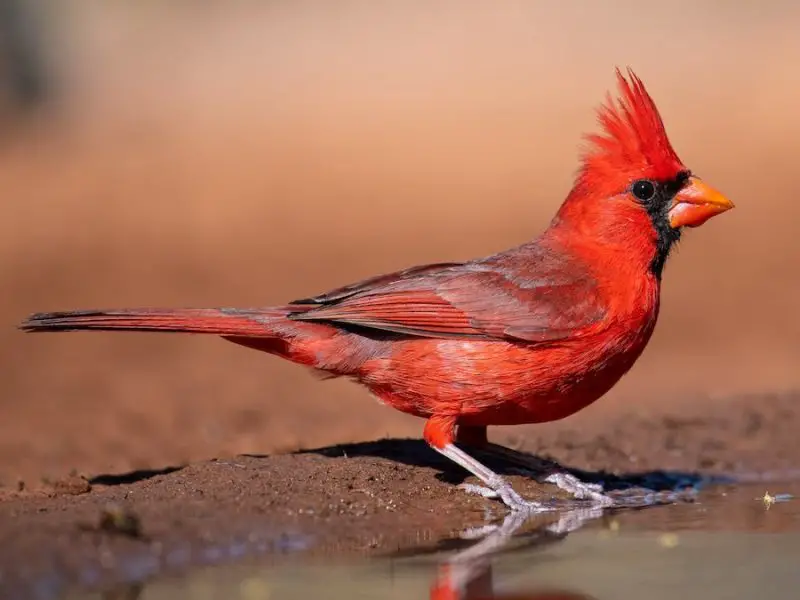
The Northern Cardinal is one of the most iconic and recognizable birds in Alabama, especially the bright red males with their striking black mask and crest. Females are more subdued with a mix of warm browns, red tinges on the wings and tail, and a similar crest. Both sexes have strong, cone-shaped orange bills that are ideal for cracking seeds. These birds are medium-sized songbirds, typically around 8–9 inches in length.
Cardinals are year-round residents in Alabama and are commonly found in suburban backyards, woodland edges, thickets, and shrubby areas. They are frequent visitors to bird feeders, especially those stocked with sunflower seeds. Their presence is often marked by their clear, whistling songs that sound like “cheer-cheer-cheer” or “birdy-birdy-birdy,” often sung from a high perch by both males and females.
Their diet primarily consists of seeds, grains, fruits, and insects. Cardinals forage both on the ground and in low vegetation. They are territorial birds, especially during breeding season, when males can often be seen attacking their reflection in mirrors or windows, mistaking it for a rival. Their bright plumage, pleasant songs, and adaptability to human presence make them one of Alabama’s most beloved backyard birds.
Carolina Wren (Thryothorus ludovicianus)
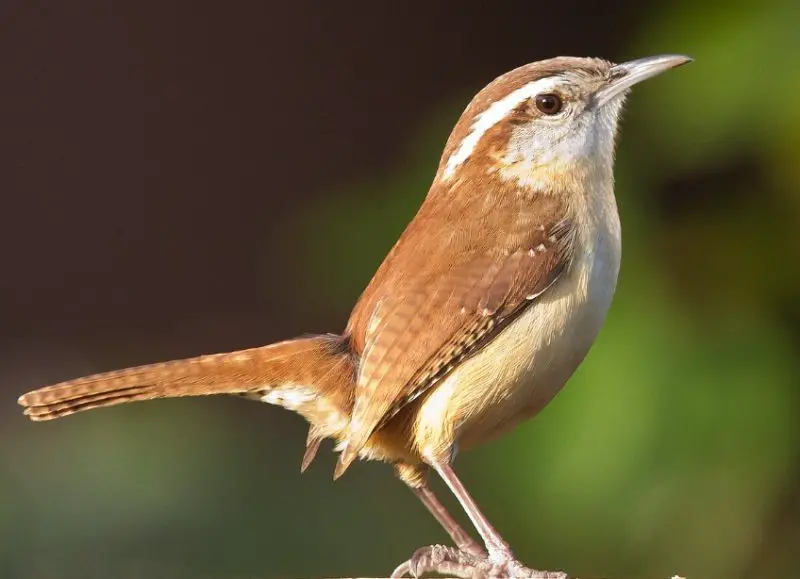
The Carolina Wren is a small, round-bodied bird with a rich cinnamon-brown back, buff-colored underparts, and a distinct white eyebrow stripe. It has a slightly curved bill and an upright tail often flicked energetically. Despite its small size, this bird is known for its loud and far-reaching voice.
Carolina Wrens are non-migratory and can be found throughout Alabama in a variety of habitats including suburban gardens, woodlands, brush piles, and even garages or porches. They often nest in unusual places such as flowerpots, mailboxes, and hanging baskets. Their song is a loud, rolling “tea-kettle, tea-kettle, tea-kettle,” repeated several times and sung mostly by males.
Their diet includes insects like spiders, beetles, and caterpillars, along with some berries and seeds. These wrens forage close to the ground, probing crevices and leaf litter for prey. They are active, curious, and often seen hopping through underbrush or climbing low tree trunks. Their adaptability and strong voice make them easy to notice even when they’re hidden among dense vegetation.
Tufted Titmouse (Baeolophus bicolor)
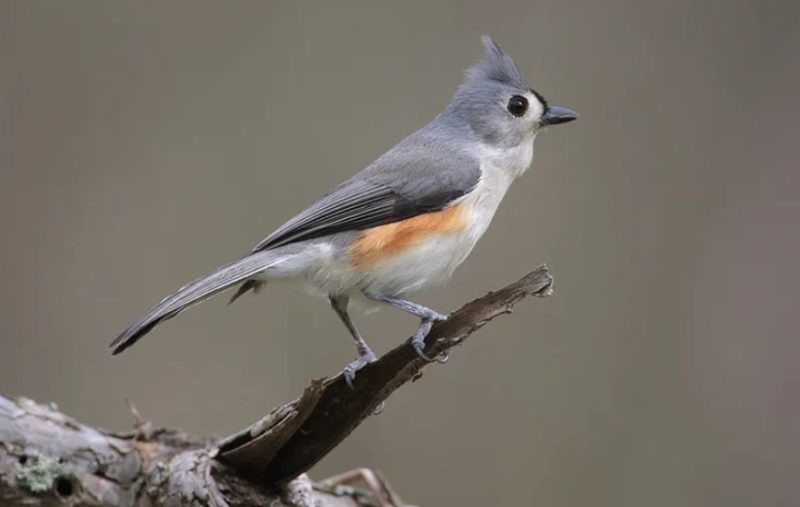
The Tufted Titmouse is a small songbird with a sleek gray body, white underparts, and a distinct crest on its head. It has large, dark eyes and a black patch just above the beak. This bird has a gentle and curious appearance, often seen moving in small groups with chickadees and nuthatches.
In Alabama, Tufted Titmice are common in deciduous and mixed woodlands, parks, and residential areas with mature trees. They are year-round residents and frequently visit backyard feeders, especially those offering sunflower seeds, peanuts, and suet. Their vocalizations include a clear “peter-peter-peter” whistle and a variety of soft calls used for communication within family groups.
They feed on insects, seeds, nuts, and berries, often storing food in bark crevices for later use. Tufted Titmice are agile foragers, hanging upside down from branches and probing into bark and twigs. They are cavity nesters, often using natural tree holes or old woodpecker nests, and readily use nest boxes. Their social nature and friendly appearance make them favorites among birdwatchers in Alabama.
Blue Jay (Cyanocitta cristata)

The Blue Jay is a large, boldly colored songbird with bright blue plumage, a white face and underparts, and a black necklace-like collar. Its wings and tail are patterned with black and white bars, and its expressive crest is often raised or lowered depending on its mood. Blue Jays have strong bills and are excellent mimics, sometimes imitating the calls of hawks.
They are year-round residents in Alabama and thrive in forests, especially oak woodlands, as well as suburban neighborhoods. Blue Jays are known for their intelligence and complex social behavior. They often travel in noisy family groups, and their calls include a loud “jay jay” and a variety of whistles, clicks, and mimicry of other birds.
Their diet is omnivorous, consisting of acorns, seeds, insects, and occasionally small vertebrates or bird eggs. They are known to cache food for later and play an important role in seed dispersal, especially of oak trees. While their loud and aggressive behavior can sometimes disturb smaller birds, they are an essential part of Alabama’s woodland bird communities.
Northern Mockingbird (Mimus polyglottos)
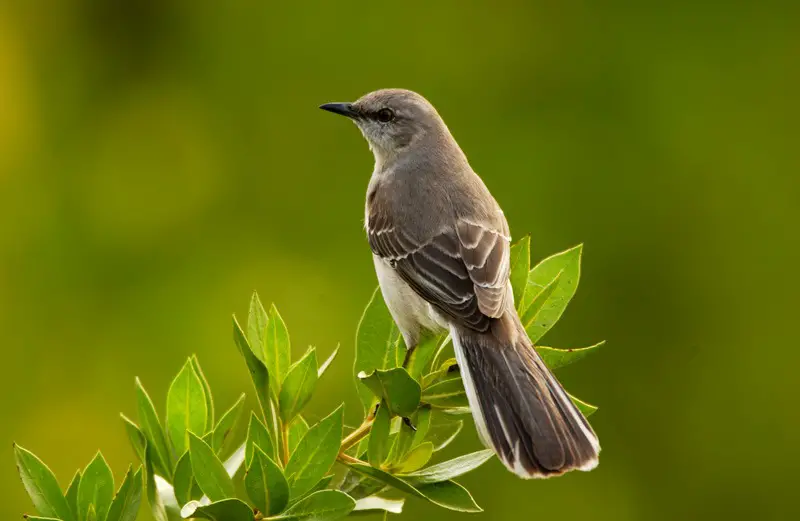
The Northern Mockingbird is a slender, medium-sized songbird with a gray back, whitish belly, and long tail edged with white. Its wings also have bold white patches that are especially noticeable during flight. This bird is famous for its vocal talents and ability to mimic the songs of other birds, animals, and even mechanical noises.
Northern Mockingbirds are found across Alabama throughout the year and prefer open areas with shrubs and trees, including suburban neighborhoods, parks, and farmland. They are often seen perched on rooftops, fences, or telephone wires, singing loudly and persistently. Males may sing through the night, especially during breeding season, and they can produce a repertoire of up to 200 different song variations.
Their diet consists of insects during the warmer months and fruits and berries in winter. They forage on the ground or in shrubs, often running and flashing their wing patches to startle insects. Mockingbirds are highly territorial and known for aggressively defending their nesting areas from intruders, including much larger animals. Their boldness, mimicry, and frequent presence in human environments make them one of Alabama’s most recognizable birds.
Eastern Bluebird (Sialia sialis)
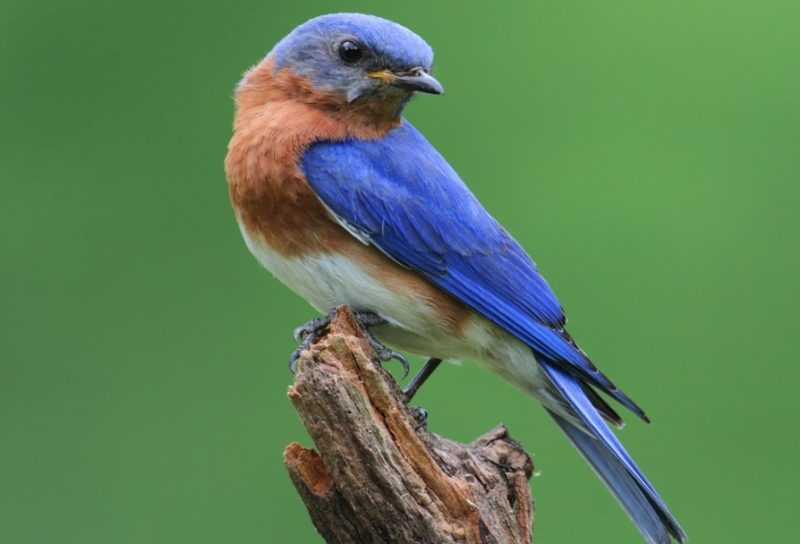
The Eastern Bluebird is a small thrush with vivid royal blue upperparts and a warm reddish-orange chest and throat, with a white belly. Females are more subdued in coloration, with grayish-blue wings and paler orange coloring. This bird is often described as a symbol of happiness due to its brilliant color and soft warbling song.
In Alabama, Eastern Bluebirds are commonly found in open fields, orchards, pastures, and suburban areas with scattered trees and low ground cover. They are cavity nesters and will use nest boxes, especially when placed near open grassy spaces. Their sweet, musical “cheer-cheerful-charmer” song is a familiar sound in rural and suburban landscapes throughout the state.
Eastern Bluebirds feed primarily on insects like beetles, caterpillars, and grasshoppers during the spring and summer. In colder months, their diet shifts more toward berries and small fruits. They often perch on low branches or wires, scanning the ground before fluttering down to catch prey. Their calm demeanor and vibrant plumage make them a favorite among birdwatchers and backyard bird enthusiasts.
American Goldfinch (Spinus tristis)
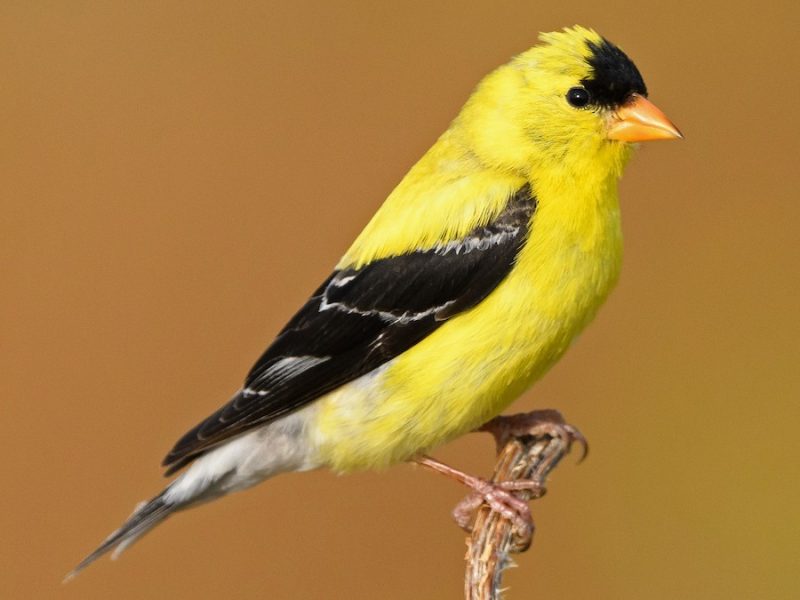
The American Goldfinch is a small, active finch known for its bright yellow plumage in males during the breeding season, contrasting with black wings and cap. Females and non-breeding males are duller, with more olive and brown tones. This bird has a conical bill perfect for seed-eating and a distinct, bouncy flight pattern.
American Goldfinches are widespread in Alabama and are most often seen in weedy fields, roadsides, gardens, and at feeders, especially those offering nyjer (thistle) and sunflower seeds. They are more common in the state during the breeding season but can be found year-round. Their cheerful “per-chick-o-ree” flight call and sweet, canary-like song are delightful additions to any outdoor setting.
Their diet consists almost entirely of seeds, making them one of the strictest vegetarians among songbirds. They forage acrobatically, often hanging upside-down on flower heads to extract seeds. Unlike many birds, American Goldfinches breed late in the summer when seed supplies peak. Their vibrant plumage, gentle calls, and peaceful behavior make them a favorite visitor to Alabama’s feeders and wildflower meadows.
Carolina Chickadee (Poecile carolinensis)
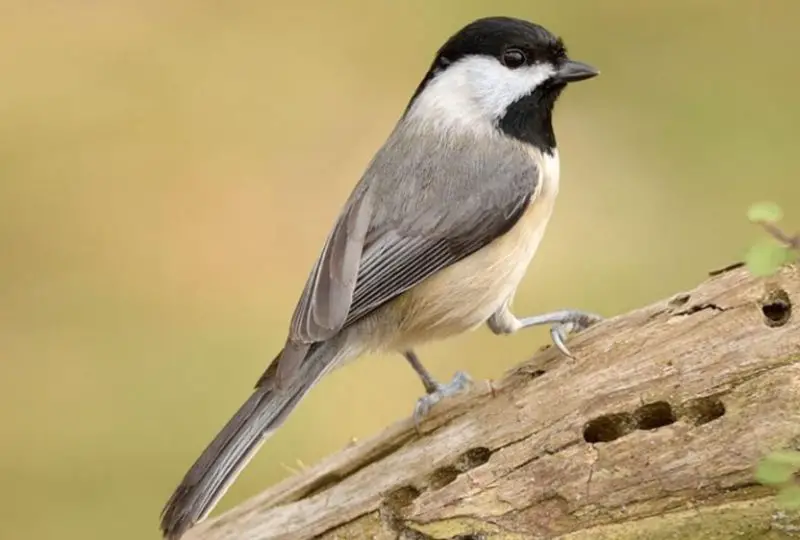
The Carolina Chickadee is a small, round-bodied bird with a black cap and bib, white cheeks, and soft gray upperparts. Its underparts are pale gray or buff, and it has a short, stubby bill. It is very similar in appearance to the Black-capped Chickadee but is the dominant chickadee species in Alabama.
Carolina Chickadees live in mixed and deciduous woodlands, as well as suburban yards, parks, and areas with mature trees throughout Alabama. They are year-round residents and frequent visitors to feeders, where they eagerly take sunflower seeds and suet. Their familiar “chick-a-dee-dee-dee” call and sweet, whistled “fee-bee fee-bay” song are commonly heard in the trees.
These birds eat insects, spiders, seeds, and berries, often foraging by hanging from twigs and branches. They are cavity nesters and will readily use birdhouses. Carolina Chickadees are intelligent and curious, often the first to investigate new feeders or changes in their environment. Their social nature and endearing behavior make them beloved backyard birds across Alabama.
Red-bellied Woodpecker (Melanerpes carolinus)
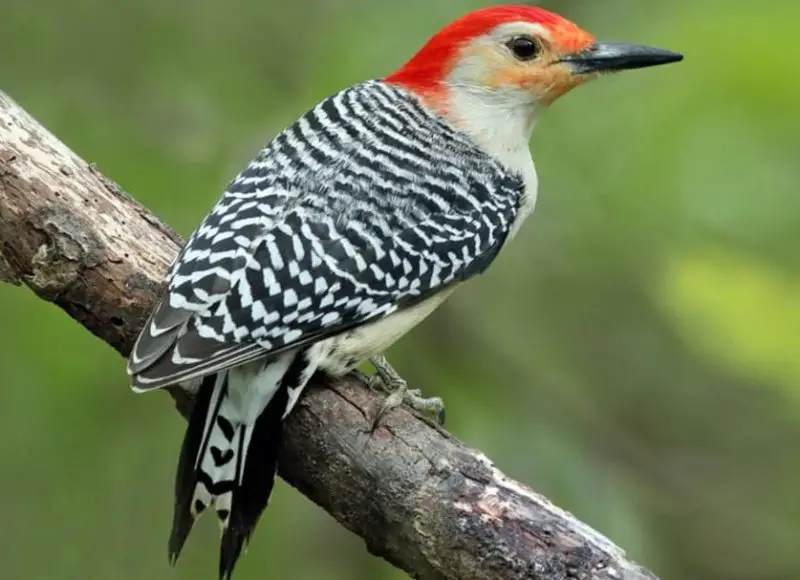
The Red-bellied Woodpecker is a medium-sized woodpecker with a pale, lightly reddish belly that is often hard to see. It has striking black-and-white barred wings and back, and a bright red crown and nape in males, with females lacking the red on the crown. Its chisel-like bill and zygodactyl feet are well-suited for climbing and drumming on trees.
In Alabama, Red-bellied Woodpeckers are found year-round in forests, wooded suburbs, and parks. They are common visitors to feeders, especially for suet, peanuts, and sunflower seeds. Their rolling calls—described as “churr” or “querr”—are loud and distinctive, and they also drum frequently on tree trunks or even metal objects.
They feed on insects, nuts, fruits, and seeds, often foraging along tree trunks and large branches, probing into bark and crevices. Red-bellied Woodpeckers also cache food in bark for later consumption. Despite the confusing name, their red head is more visible than their faintly reddish belly, making them one of Alabama’s most easily recognized woodpeckers.
Downy Woodpecker (Dryobates pubescens)
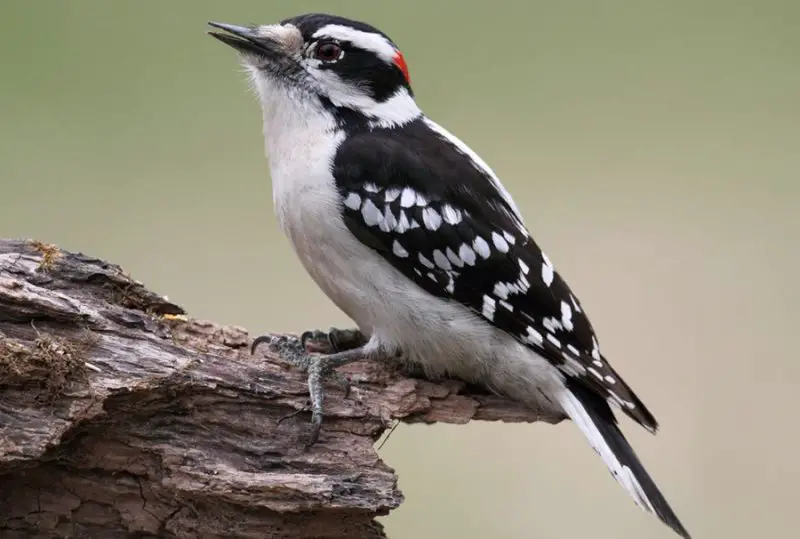
The Downy Woodpecker is the smallest woodpecker in North America, with black-and-white plumage, a white back, and white underparts. Males have a small red patch on the back of the head, while females lack this marking. Its short bill is smaller than that of other woodpeckers, giving it a gentle appearance.
Downy Woodpeckers are widespread and common throughout Alabama in wooded areas, gardens, orchards, and suburbs. They are frequent visitors to feeders, particularly suet feeders, and can often be seen creeping along branches and tree trunks. Their soft “pik” calls and descending whinny-like trill are common sounds in wooded backyards.
They feed on insects, larvae, seeds, and berries, foraging by tapping and probing bark and stems. Despite their small size, they are hardy and active foragers, often joining mixed-species flocks in winter. Downy Woodpeckers also nest in tree cavities and will use nest boxes. Their adaptability, small size, and frequent visits to feeders make them a familiar and welcome sight across Alabama.
Mourning Dove (Zenaida macroura)
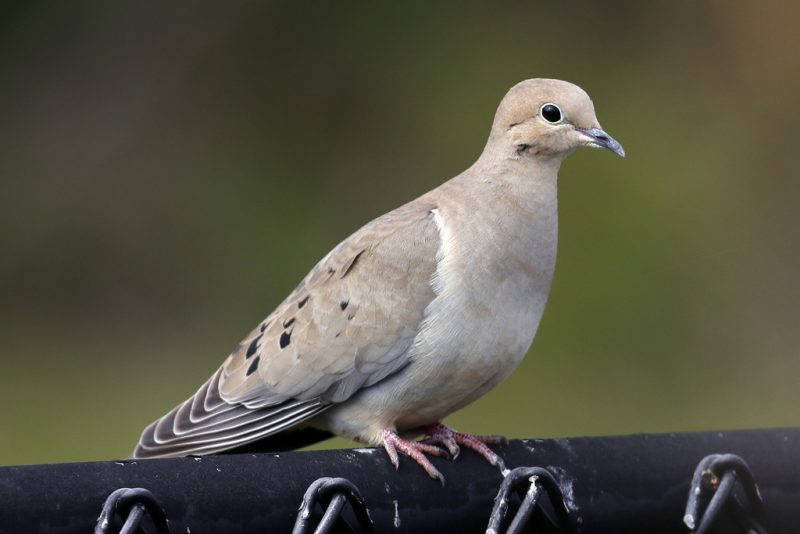
The Mourning Dove is a slender, medium-sized bird with a light brown body, black spots on the wings, and a long, pointed tail edged in white. It has a small head and a soft, sorrowful expression, with a subtle iridescence on its neck. Its cooing song is slow and mournful, which gives the bird its name and is a familiar sound across Alabama.
Mourning Doves are found statewide in Alabama in open fields, woodlands edges, urban areas, and farmlands. They are highly adaptable and often seen perched on wires, fences, or feeding on the ground beneath bird feeders. They prefer scattered trees or brush for nesting and are capable of producing multiple broods each year due to Alabama’s mild climate.
These doves feed almost exclusively on seeds, foraging mostly on the ground. They consume a variety of grains, wild seeds, and occasionally small gravel to aid digestion. Mourning Doves are peaceful and gentle in nature, often seen in pairs or small flocks, and their soft-winged whistles in flight are a common sound in Alabama backyards and countryside alike.
House Finch (Haemorhous mexicanus)
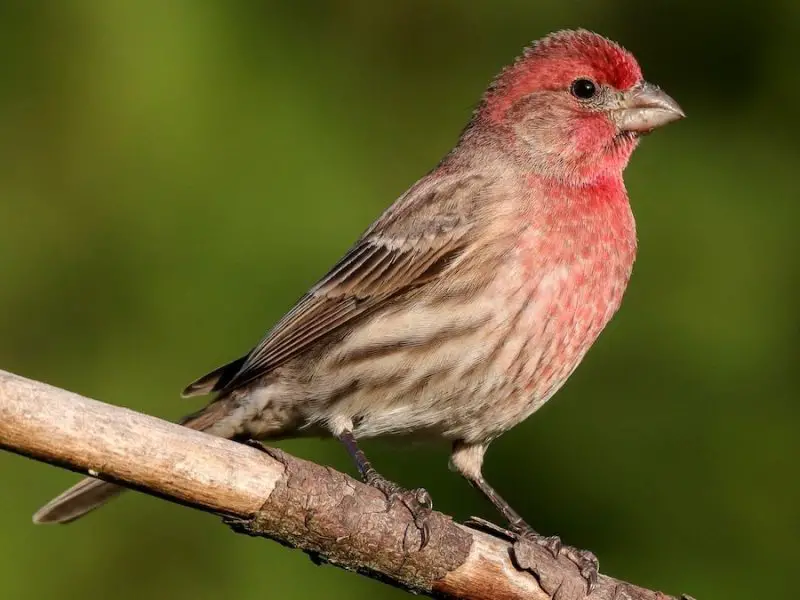
The House Finch is a small, sociable finch with a streaked brown body and, in males, a bright red head, chest, and rump. Females lack the red coloring and have plain brown streaking overall. These birds have a slightly curved bill and a cheerful, warbling song that adds energy to any neighborhood they inhabit.
In Alabama, House Finches are commonly found in residential areas, parks, farms, and city centers. They are year-round residents and are particularly fond of backyard feeders stocked with sunflower seeds or millet. They build nests in hanging planters, building crevices, and even wreaths on porches, adapting well to human-made environments.
House Finches primarily eat seeds, buds, and fruits, occasionally feeding on insects. They are gregarious and often feed in flocks, both in wild spaces and urban areas. Their persistent singing, bold behavior, and attractive coloration make them a delightful and familiar presence throughout Alabama’s communities.
Eastern Towhee (Pipilo erythrophthalmus)
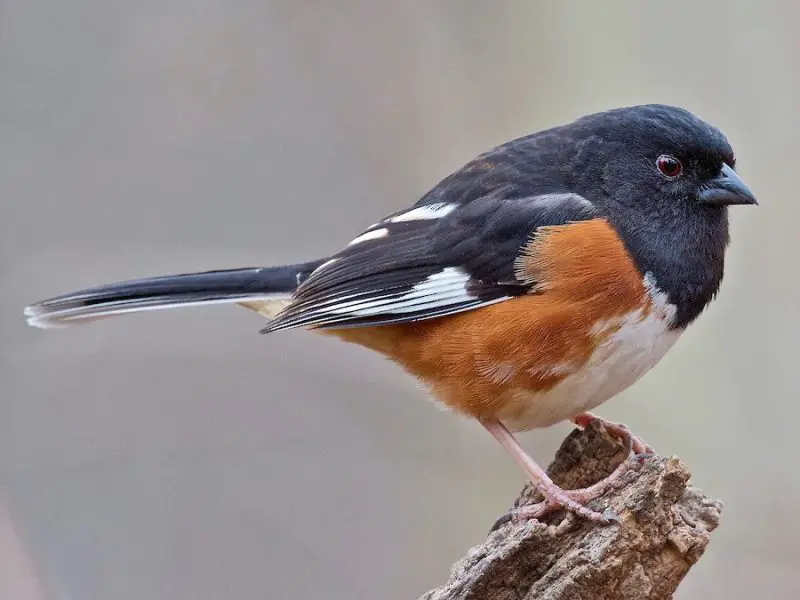
The Eastern Towhee is a striking songbird with a black head, back, and tail in males, rufous sides, and a white belly. Females are similar but with brown replacing black. Their bright red eyes and bold coloration make them easily distinguishable when seen in clear view, though they often stay hidden in underbrush.
Eastern Towhees are found across Alabama in shrubby areas, forest edges, thickets, and overgrown fields. They spend much of their time on the ground, scratching through leaf litter in a two-footed hop to uncover insects and seeds. Their song sounds like “drink-your-tea” and is often heard before the bird is seen.
Their diet includes a mix of insects, spiders, fruits, and seeds. During the breeding season, insects make up a larger part of their food intake. Eastern Towhees are ground nesters and can be elusive, but their vocalizations and striking appearance reward patient birdwatchers in Alabama’s brushy habitats and wooded suburbs.
Brown Thrasher (Toxostoma rufum)
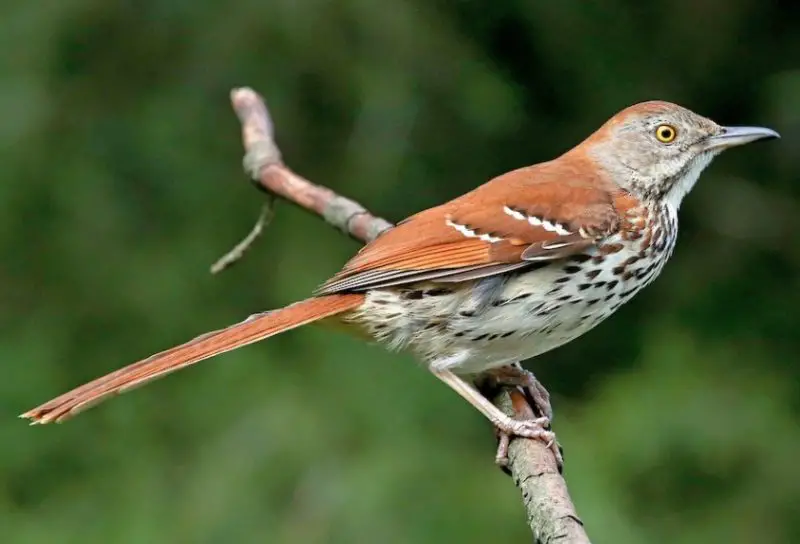
The Brown Thrasher is a long-tailed, reddish-brown bird with a slightly curved bill and bold dark streaks across its whitish chest. It has bright yellow eyes and a fairly large size compared to most backyard birds. Known for its extensive vocal ability, the Brown Thrasher can mimic other birds and has a song repertoire of over a thousand phrases.
This species is widespread throughout Alabama in dense shrubs, hedgerows, forest edges, and suburban areas with thick vegetation. Although they are often hidden, their rich, whistled songs can be heard from within the foliage. Brown Thrashers are typically solitary and can be defensive of their nesting territory.
They forage mostly on the ground, flipping leaves and debris with their bills to find insects, seeds, and berries. In the fall and winter, fruits make up more of their diet. Brown Thrashers are year-round residents in Alabama and provide a musical presence to wooded and brushy environments with their remarkable vocal variety.
Chipping Sparrow (Spizella passerina)
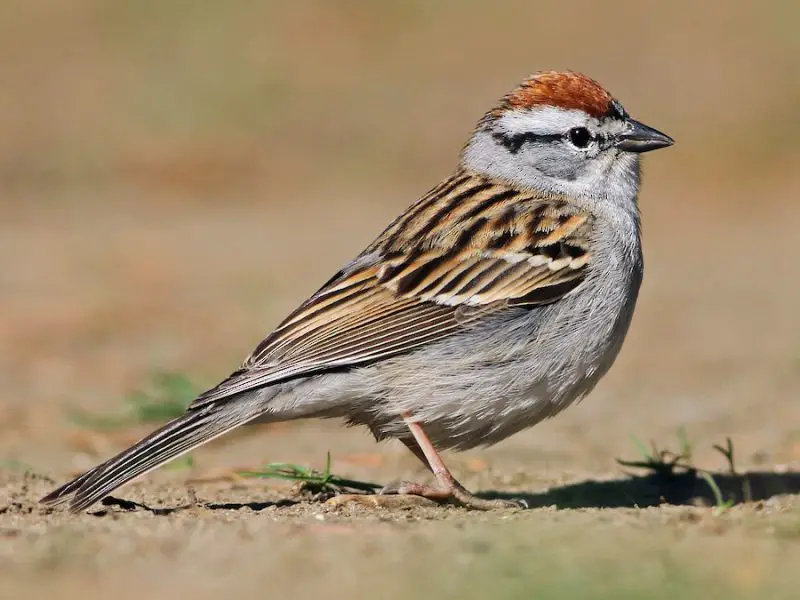
The Chipping Sparrow is a small, slender sparrow with a bright rufous cap, a black eye line, and a pale gray underbody. Its fine bill and crisp plumage give it a clean, alert appearance. During the breeding season, its dry, mechanical trill can be heard frequently in open areas and yards.
In Alabama, Chipping Sparrows are common in open woodlands, grassy fields, parks, and residential lawns, especially where scattered trees provide nesting spots. They are particularly noticeable in spring and fall during migration, but many also remain through winter in parts of the state.
Chipping Sparrows feed mainly on seeds, especially grass and weed seeds, and also take insects during the breeding season. They forage on the ground or low vegetation and often visit feeders, especially in winter. These sparrows are social and often form loose flocks outside the breeding season, making them easy to observe in many parts of Alabama.
White-throated Sparrow (Zonotrichia albicollis)

The White-throated Sparrow is a medium-sized sparrow easily recognized by its white throat patch, bold black-and-white striped head, and bright yellow lores between the bill and eyes. Some individuals have a tan-striped variation, but all share the same clear, whistled song, often transcribed as “Oh-sweet-Canada-Canada.”
This species is a common winter visitor in Alabama, favoring wooded edges, brushy fields, parks, and backyards with dense cover. During colder months, they forage in flocks on the ground, scratching in leaf litter or snow for seeds and fallen berries. Their behavior is often shy but persistent, especially near low vegetation or under feeders.
White-throated Sparrows feed primarily on seeds and fruits in winter and shift to insects and small invertebrates during breeding season. Though they do not typically breed in Alabama, their presence from late fall through early spring makes them a welcome and musical sight in gardens and natural spaces across the state.
American Robin (Turdus migratorius)
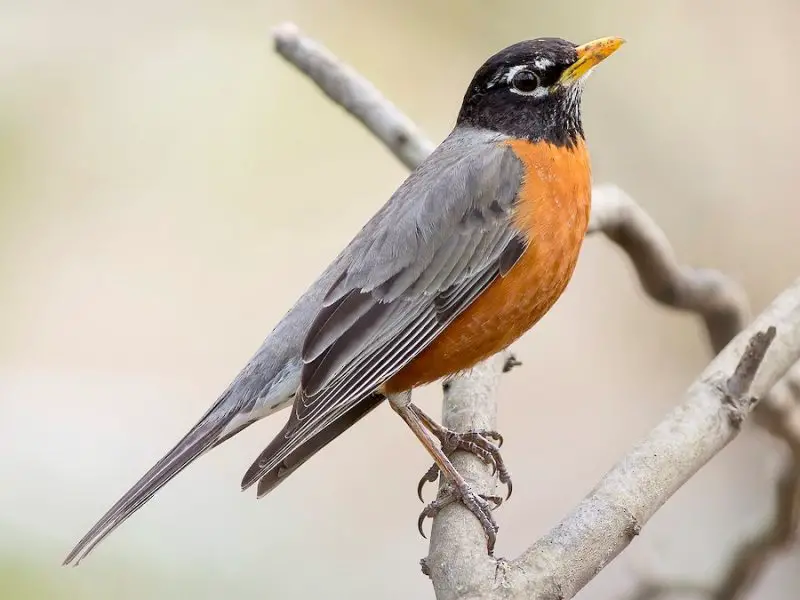
The American Robin is a large, familiar thrush with a warm orange breast, grayish back, and a yellow bill. Its upright stance and bold presence make it easy to identify. Its song is a series of rich, whistling phrases that often signals the arrival of spring across North America.
In Alabama, American Robins are year-round residents, though their numbers increase during migration. They are highly adaptable and can be seen in a wide range of habitats, including lawns, woodlands, parks, and suburban neighborhoods. They are often observed hopping across grassy areas in search of food.
Robins primarily eat earthworms, insects, and berries. They are known for their methodical hunting behavior, cocking their head to locate worms underground. During colder months in Alabama, they shift to a diet heavy in fruits like holly, dogwood, and privet berries, often forming large, noisy winter flocks.
Northern Flicker (Colaptes auratus)

The Northern Flicker is a large, brown woodpecker with black barring on the back, a spotted belly, and a prominent black crescent on the chest. In Alabama, the “yellow-shafted” variety is common and distinguished by its bright yellow underwings and tail feathers, along with a red patch on the back of the head.
These birds are found in open woodlands, forest edges, and suburban areas with scattered trees. Unlike most woodpeckers, Northern Flickers often forage on the ground, using their slightly curved bill to dig for ants and beetles, their primary food source. Their call is a loud “kleer” and their rhythmic drumming can be heard during the breeding season.
Northern Flickers eat a variety of insects, especially ants and other ground-dwelling species, and will also consume fruits and seeds. They excavate nest cavities in dead or decaying trees and may use nest boxes. Their striking plumage and unusual foraging behavior make them one of the most unique woodpeckers in Alabama.
Yellow-rumped Warbler (Setophaga coronata)
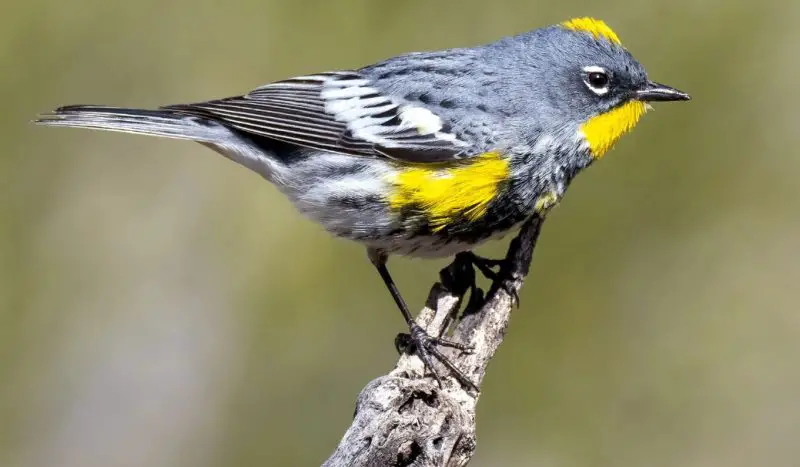
The Yellow-rumped Warbler is a small, active warbler with a gray body, yellow patches on the sides, rump, and crown, and white wing bars. Females and non-breeding birds appear more brownish, but still show the characteristic “butter butt.” Their call is a sharp “check,” and their song is a soft, musical trill.
This warbler is a common winter visitor in Alabama, found in forests, pine stands, parks, and even urban areas. It is one of the few warblers that can survive colder seasons in the U.S. due to its unique ability to digest waxes found in bayberries and wax myrtle, which are abundant in the South.
While insects form the core of their diet in warmer months, Yellow-rumped Warblers consume berries and fruit in winter. They are agile, foraging in trees and shrubs or occasionally hovering and flycatching. Their high-pitched calls and constant motion make them an entertaining presence during Alabama’s cooler months.
Pine Warbler (Setophaga pinus)
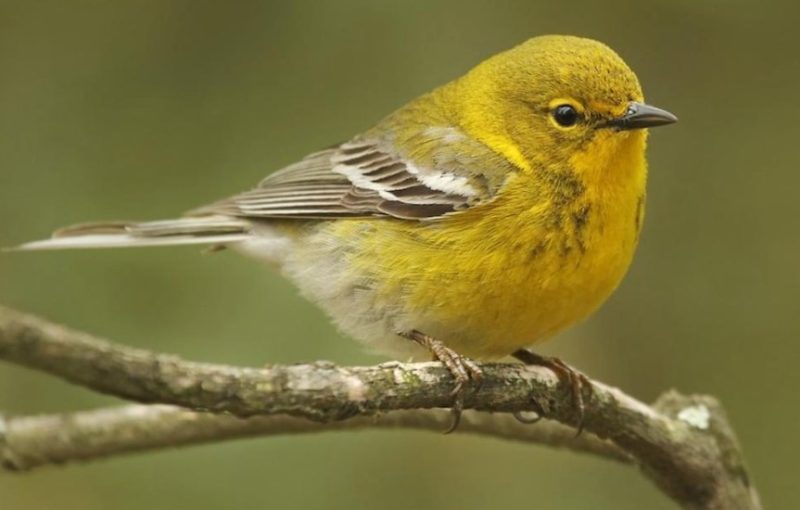
The Pine Warbler is a plump, yellowish warbler with olive-green upperparts, faint wing bars, and a relatively thick bill. Males are brighter, while females and juveniles appear duller and more grayish-yellow. Its trilling song is one of the earliest bird songs heard in Alabama during spring.
True to its name, the Pine Warbler is closely associated with pine forests and is a year-round resident throughout much of Alabama. It can be found foraging in the canopy of pine trees, often blending in with the needles as it moves methodically through branches in search of food.
Pine Warblers primarily eat insects but will also consume seeds and fruits, especially in winter. They are one of the few warblers that regularly visit bird feeders, particularly for suet and cracked corn. Their strong connection to pine habitats and their early spring vocalizations make them a reliable indicator of changing seasons in Alabama’s forests.
Eastern Phoebe (Sayornis phoebe)
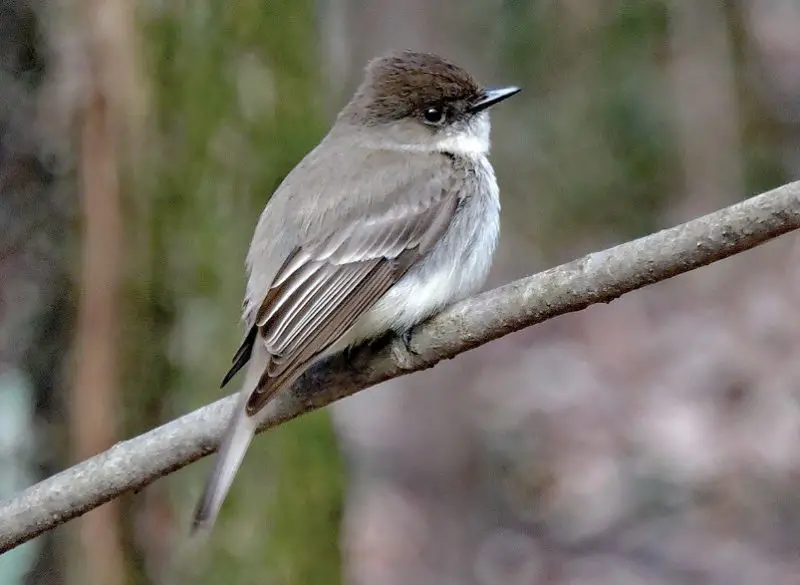
The Eastern Phoebe is a small, plain flycatcher with a grayish-brown back, a whitish belly, and a dark head that often appears slightly crested. It is best recognized by its characteristic tail-wagging behavior and sharp, raspy “fee-bee” call, which is frequently repeated and gives the bird its name.
In Alabama, Eastern Phoebes are early harbingers of spring and are commonly found near water, woodlands, rural buildings, and bridges. They prefer open or semi-open areas where they can perch on low branches, fences, or wires to survey for flying insects. They are one of the few flycatchers that breed early in the season, often reusing the same nest sites year after year.
Eastern Phoebes feed primarily on insects such as flies, beetles, wasps, and grasshoppers, which they catch on the wing. In cooler months or when insect availability is low, they supplement their diet with berries. Their adaptability to human structures for nesting makes them a familiar presence around homes and barns in Alabama’s countryside.
Great Crested Flycatcher (Myiarchus crinitus)

The Great Crested Flycatcher is a large, colorful flycatcher with a lemon-yellow belly, olive upperparts, and a rusty-red tail and wing edges. It has a strong, slightly crested head and a loud, distinctive call that sounds like “whee-eep,” often heard echoing through wooded areas.
This species is a summer resident in Alabama and favors mature deciduous forests, forest edges, and wooded suburbs. Unlike many flycatchers that hunt in open areas, the Great Crested Flycatcher often stays high in the canopy, sallying out to catch flying insects and then returning to a perch to consume them. It nests in tree cavities and will readily use nest boxes.
Its diet is mainly composed of large insects such as butterflies, moths, caterpillars, and beetles, but it also eats fruits and berries in late summer. One of its most unique behaviors is incorporating shed snake skins into its nest lining, a trait that may deter predators. Its loud, ringing calls and bright plumage make it a striking yet often unseen presence in Alabama’s woodlands.
Barn Swallow (Hirundo rustica)
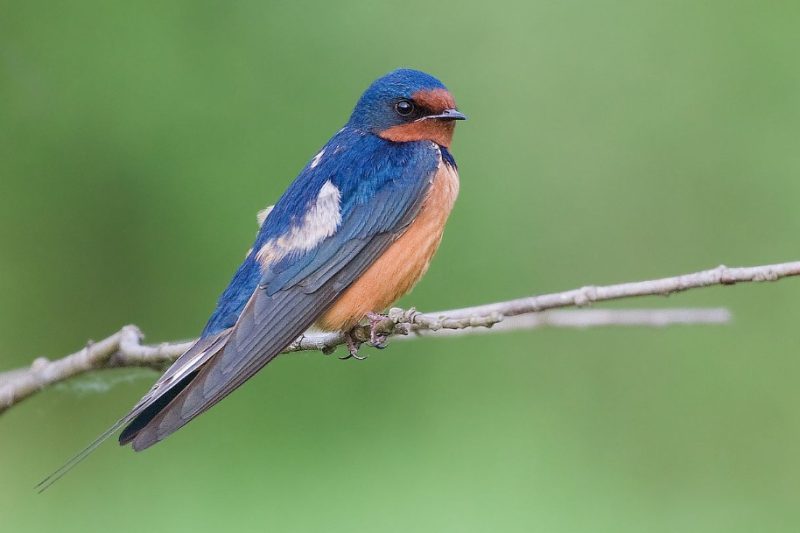
The Barn Swallow is a sleek, agile songbird with a glossy blue back, rufous throat and forehead, and a deeply forked tail. Its graceful flight and cheerful, twittering song are characteristic sights and sounds of open fields, farmlands, and towns throughout Alabama during the warmer months.
Barn Swallows build mud-cup nests under eaves, bridges, and barns, often in colonies. They are expert aerial insectivores, catching flies, beetles, and other flying insects while in flight. Their flight is fast, acrobatic, and continuous, usually low over fields or water, making them efficient hunters and entertaining to watch.
These swallows are long-distance migrants, wintering in Central and South America and returning to Alabama in spring to breed. Their dependence on human structures for nesting and their tolerance of human activity have made them one of the most widespread swallow species in North America. They symbolize the return of spring and are beloved for their graceful flight and cheerful presence.
Purple Martin (Progne subis)
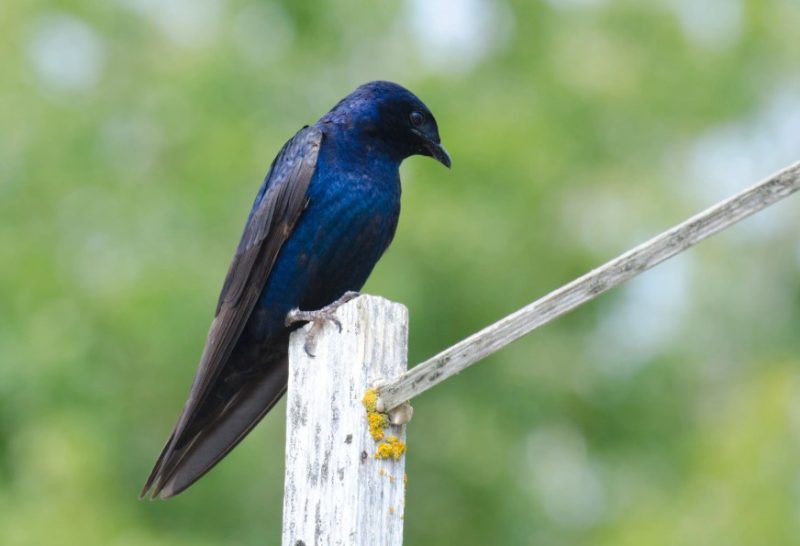
The Purple Martin is the largest North American swallow, with glossy, dark blue-black plumage in adult males and lighter grayish underparts in females and juveniles. These birds are highly social, often nesting in colonies and filling the air with a variety of chirping and gurgling calls.
In Alabama, Purple Martins are summer residents, often relying entirely on human-provided nesting structures such as birdhouses and martin condos. They prefer open areas near water or fields where they can easily forage. Their arrival in early spring is eagerly anticipated by bird enthusiasts who maintain housing specifically to attract them.
Purple Martins feed exclusively on flying insects, including dragonflies, beetles, moths, and mosquitoes. They soar and glide with elegance, typically high in the air compared to other swallows. Their dependence on human-made nesting sites and their loud, social nature make them a unique part of Alabama’s birding culture during the warmer months.
Common Grackle (Quiscalus quiscula)

The Common Grackle is a large, long-legged blackbird with iridescent blue, purple, or green sheen depending on the light. Its eyes are bright yellow, and its long tail is often keel-shaped in flight. Though visually striking, its harsh “chack” call and noisy gatherings are less appreciated by some.
Grackles are common year-round residents in Alabama and thrive in a variety of habitats including suburban lawns, agricultural fields, wetlands, and woodlands. They often gather in large flocks, sometimes mixed with other blackbirds and starlings, especially outside the breeding season. Their communal roosting behavior can be quite loud and conspicuous.
Omnivorous and opportunistic, Common Grackles eat insects, seeds, grains, fruits, and even small vertebrates like frogs or baby birds. They forage on the ground, in shallow water, or on trees, and can be seen raiding crops or visiting bird feeders. Though not always welcome in gardens, their shimmering plumage and bold behavior make them a recognizable part of Alabama’s avian scene.
Brown-headed Cowbird (Molothrus ater)

The Brown-headed Cowbird is a small blackbird with a glossy black body in males and a distinctive brown head. Females are more subdued in appearance, with plain gray-brown plumage. The male’s bubbling, gurgling song is often heard in open fields and at forest edges during the breeding season.
This species is well-known for its brood parasitism, as females lay their eggs in the nests of other birds, leaving the host species to raise their young. In Alabama, Brown-headed Cowbirds are commonly found in agricultural areas, pastures, and suburban lawns where host birds and food are plentiful. They often forage in mixed flocks with blackbirds and starlings.
Their diet consists primarily of seeds and insects, which they glean from the ground in open spaces. Cowbirds can be controversial due to their nesting behavior, which can reduce the reproductive success of smaller songbirds. Nevertheless, they play a role in the complex ecological web of Alabama’s open country and woodland margins.
Red-winged Blackbird (Agelaius phoeniceus)
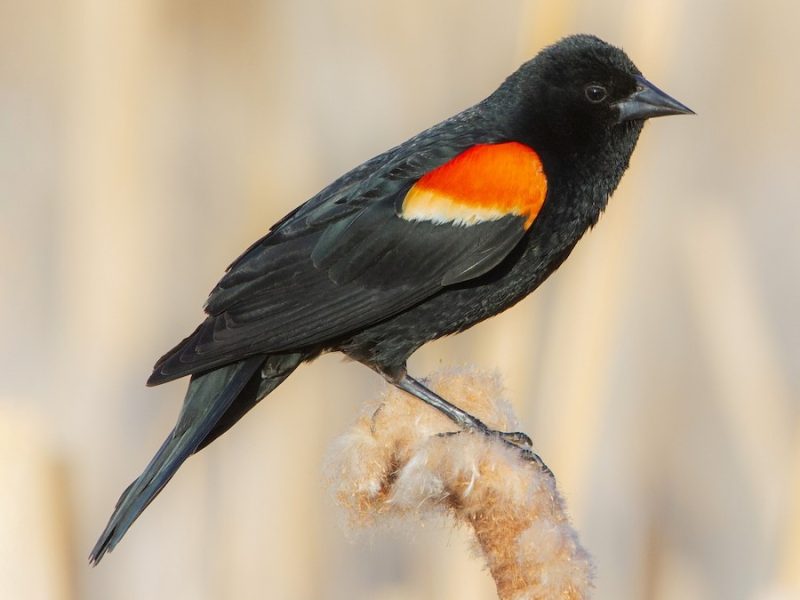
The Red-winged Blackbird is easily recognized by the striking red and yellow shoulder patches, or epaulets, of the adult male, which contrast with its glossy black body. Females are streaky brown and resemble sparrows in appearance, often mistaken for a different species altogether. Their familiar “conk-la-ree!” call is a staple of wetlands and marshes.
In Alabama, Red-winged Blackbirds are commonly seen in freshwater wetlands, roadside ditches, and agricultural fields. They are especially visible during the spring and summer months, when males perch atop cattails and shrubs to defend their territory and attract mates. They are also found at feeders and in grassy habitats outside of the breeding season.
Their diet includes seeds, grains, and insects, which they forage for both on the ground and among vegetation. They often form large flocks in winter, sometimes mixing with grackles and starlings. Their presence adds color and sound to Alabama’s wetland environments and makes them one of the most recognizable blackbirds in the region.
European Starling (Sturnus vulgaris)
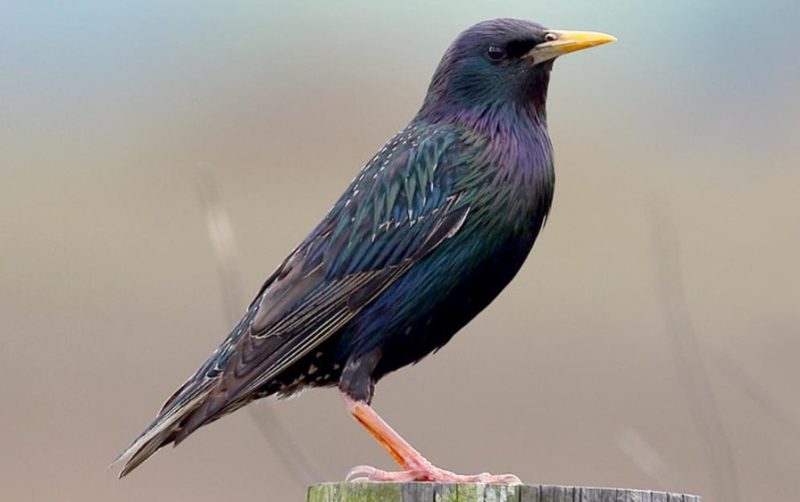
The European Starling is a stocky, short-tailed bird with iridescent black plumage that shimmers with purples and greens in the sunlight. During winter, they are heavily speckled with white, and their bright yellow bills become darker. Their vocalizations are a chaotic mix of whistles, clicks, and mimicry, often delivered from prominent perches.
Introduced to North America in the late 1800s, European Starlings are now widespread throughout Alabama, particularly in urban areas, farmlands, and suburban neighborhoods. They are aggressive competitors for nesting cavities, often displacing native birds such as woodpeckers and bluebirds. Starlings form massive flocks, especially in fall and winter, creating swirling aerial displays known as murmurations.
Starlings eat a varied diet of insects, fruits, and seeds, often foraging in lawns, pastures, and garbage areas. They are highly adaptable and thrive in disturbed environments, contributing to their rapid spread. While not native, their striking appearance and complex vocalizations have made them a noticeable part of Alabama’s bird population.
House Sparrow (Passer domesticus)
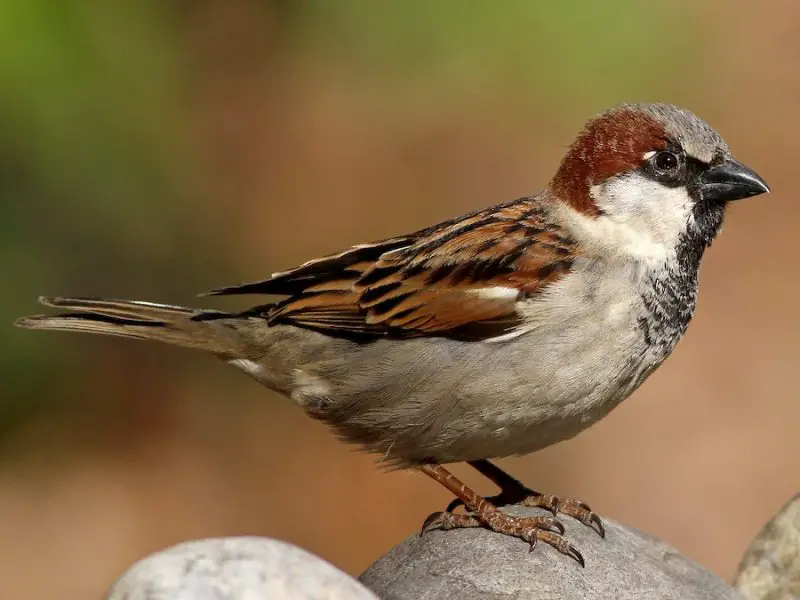
The House Sparrow is a small, chunky bird with a stout bill. Males have gray heads, white cheeks, a black bib, and chestnut napes, while females and young birds are brown and buff with subtle striping. These birds are highly social and vocal, often chattering noisily in groups near buildings.
Originally from Eurasia, House Sparrows were introduced to North America in the 19th century and have since become abundant in Alabama’s urban, suburban, and agricultural environments. They nest in eaves, vents, and crevices in buildings, often near humans, and are rarely seen far from civilization. Their nests are bulky and can displace native cavity-nesting birds.
Their diet includes seeds, grains, and crumbs from human activity, with some insects fed to nestlings. House Sparrows are common at feeders and adapt easily to new habitats. Though they are not native and can pose a threat to native species, they are one of the most familiar and widespread birds in the state.
American Crow (Corvus brachyrhynchos)
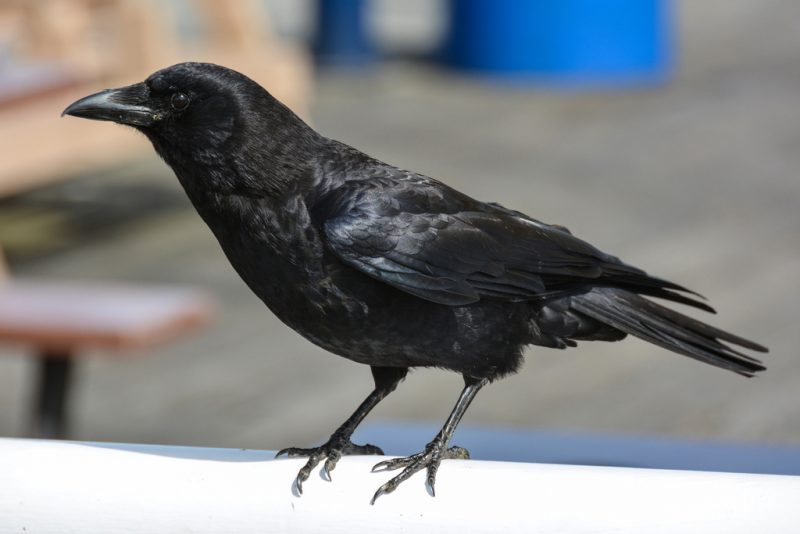
The American Crow is a large, all-black bird known for its intelligence, adaptability, and loud cawing calls. Its glossy plumage, fan-shaped tail, and strong, straight bill make it a distinctive silhouette in the sky or perched high in a tree. Crows often fly in deliberate, steady wingbeats, distinguishing them from similar species.
Crows are found throughout Alabama in a wide range of habitats, including forests, farmland, suburban areas, and even urban centers. They are highly social, often gathering in family groups or large communal roosts. Their complex vocalizations and behaviors suggest a high level of problem-solving ability and communication.
These omnivorous birds eat almost anything, including insects, grains, fruits, carrion, and garbage. They are also known to raid nests and consume eggs or nestlings. American Crows are important scavengers and play a role in cleaning the environment. Their intelligence and social nature make them one of the most fascinating birds in Alabama.
Fish Crow (Corvus ossifragus)
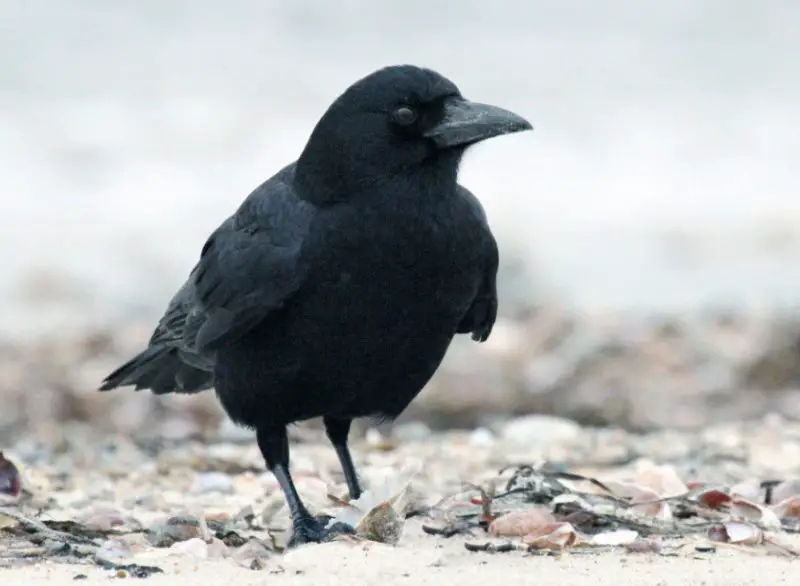
The Fish Crow is slightly smaller than the American Crow and has a more nasal and raspier call, often described as a nasal “nyuh.” It is glossy black all over with a rounded tail and sturdy build. Visually, it can be difficult to distinguish from the American Crow without hearing its distinct vocalizations.
In Alabama, Fish Crows are most commonly found near coastal areas, wetlands, rivers, and estuaries, reflecting their preference for watery habitats. They are highly adaptable and often forage in urban areas near water as well. Their social behavior includes grouping in small flocks, especially outside the breeding season.
Fish Crows primarily feed on fish, crustaceans, insects, and other small aquatic animals, often scavenging along shorelines and in tidal zones. They are opportunistic feeders and also eat carrion, eggs, and human food scraps. Their presence is an important part of Alabama’s coastal ecosystem, where they serve as both predators and scavengers.
Turkey Vulture (Cathartes aura)

The Turkey Vulture is a large bird with a wingspan that can exceed six feet. It has dark brown to black plumage, a bald red head, and a distinctive soaring flight with wings held in a shallow V-shape. Its keen sense of smell helps it locate carrion, which forms the bulk of its diet.
Turkey Vultures are widespread throughout Alabama, inhabiting forests, fields, deserts, and wetlands. They are often seen soaring high overhead, circling on thermal updrafts as they search for dead animals. These vultures roost communally in trees, caves, or abandoned buildings and play an important role in the environment by cleaning up carrion.
They feed almost exclusively on carrion, using their excellent olfactory senses to detect decaying animals from great heights. Turkey Vultures help prevent the spread of disease by consuming carcasses quickly. Their slow, graceful soaring and important ecological function make them a well-known species in Alabama skies.
Black Vulture (Coragyps atratus)
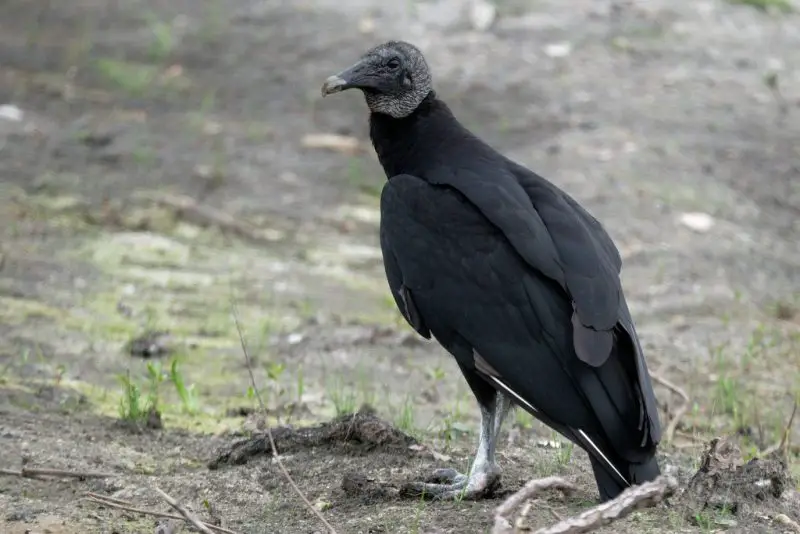
The Black Vulture is a stocky, medium-large bird with black plumage and a bare, dark gray head. Unlike the Turkey Vulture, it has shorter wings and a more direct flight pattern with rapid wingbeats. Its vocalizations are harsh and low-pitched grunts and hisses rather than calls.
In Alabama, Black Vultures are common in open areas, forests, and near human settlements. They tend to roost and nest in large groups on cliffs, trees, and abandoned structures. Their aggressive behavior and tendency to displace Turkey Vultures at carcasses make them dominant scavengers in some habitats.
They feed mainly on carrion but are more likely than Turkey Vultures to attack weak or injured animals and may occasionally eat eggs or newborn animals. Black Vultures are important for the ecosystem by cleaning up dead animals but can sometimes be a nuisance to farmers and motorists. Their bold presence and noisy behavior distinguish them from other vultures.
Killdeer (Charadrius vociferus)

The Killdeer is a medium-sized plover with striking brown upperparts, white underparts, and two distinct black bands across its chest. Its long legs and slender body allow it to run quickly on open ground. Killdeer are named for their loud, piercing “kill-deer” call often heard in open fields and shorelines.
This species is widespread in Alabama, frequenting open habitats such as fields, gravel roads, mudflats, and shorelines. Killdeer are ground-nesting birds, often laying eggs in shallow scrapes in gravel or dirt where their camouflaged eggs blend into the surroundings. They are known for their dramatic broken-wing display used to distract predators from their nests.
Killdeer primarily feed on insects, spiders, and other invertebrates, foraging by sight and running rapidly over open ground to catch prey. They are adaptable birds often seen near human activity, such as parking lots and golf courses, making them familiar and easily recognized by many residents of Alabama.
Cooper’s Hawk (Accipiter cooperii)

Cooper’s Hawk is a medium-sized raptor with a rounded tail and short, broad wings. Adults have a blue-gray back, reddish barring on the chest, and striking yellow eyes. They are agile hunters adapted for chasing birds and small mammals through dense forests.
In Alabama, Cooper’s Hawks inhabit wooded areas, forest edges, and suburban neighborhoods with mature trees. They are secretive and swift, often surprising prey with rapid bursts of flight. Nesting usually occurs high in trees, where they build stick nests used year after year.
Their diet mainly consists of medium-sized birds like doves, woodpeckers, and songbirds, but they also prey on squirrels and rodents. Cooper’s Hawks use stealth and speed to capture prey mid-flight or on the ground. Their presence is important for controlling bird populations and maintaining a balanced ecosystem in Alabama’s forests.
Red-shouldered Hawk (Buteo lineatus)

The Red-shouldered Hawk is a medium-sized raptor recognizable by its reddish barring on the chest and the distinctive rusty-red shoulders visible in flight. Its wings show bold black-and-white checkered patterns. The hawk’s call is a loud, repeating “kee-aah” that echoes through Alabama’s woodlands.
This species is common in Alabama’s deciduous forests, especially near rivers and wetlands where it nests in tall trees. It prefers mature forests with abundant prey and often perches conspicuously while hunting. The Red-shouldered Hawk is known for its territorial behavior and can be seen soaring above its woodland home during the day.
Its diet consists mainly of small mammals, amphibians, reptiles, and birds. It hunts by swooping down from a perch or gliding low through the forest to surprise prey. The Red-shouldered Hawk plays a vital role in controlling populations of rodents and other small animals in Alabama’s ecosystems.
Barred Owl (Strix varia)
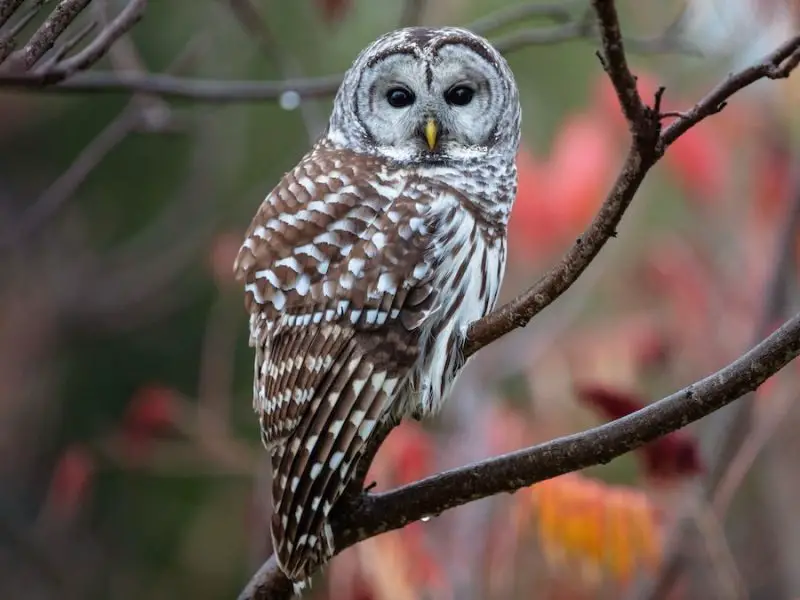
The Barred Owl is a large, stocky owl with a rounded head and no ear tufts. It is named for its distinctive horizontal barring on the chest and vertical streaks on the belly. Its dark eyes and hooting call, which sounds like “Who cooks for you? Who cooks for you all?” are familiar in Alabama’s forests.
Barred Owls inhabit mature forests with dense canopy and often nest in tree cavities or old nests of other large birds. They are mostly nocturnal but may be active at dusk and dawn. This owl prefers wooded swamps, river bottoms, and dense forests across Alabama and is known for its silent flight.
Their diet includes small mammals, birds, amphibians, and insects, which they catch using their sharp talons and excellent night vision. Barred Owls are solitary and territorial, often defending large hunting territories. They are an important predator in Alabama’s forest ecosystems, helping maintain balance in small animal populations.
Bald Eagle (Haliaeetus leucocephalus)
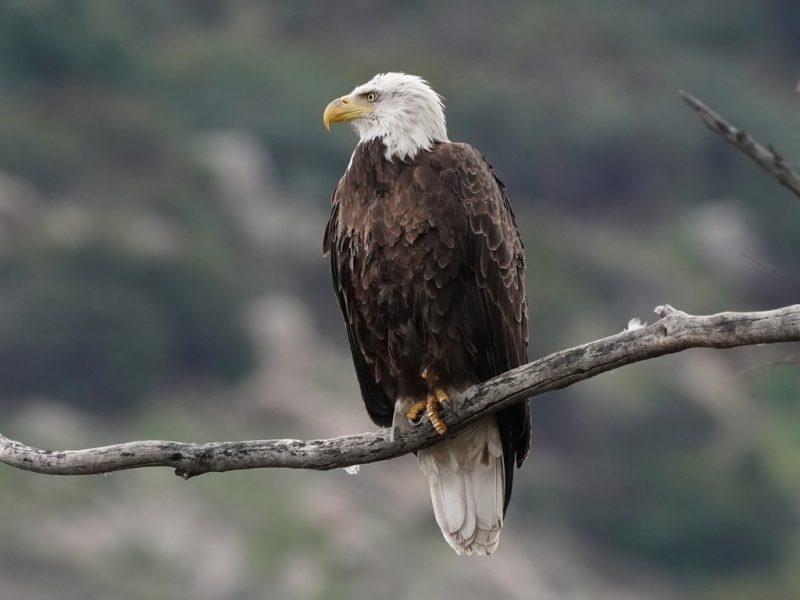
The Bald Eagle is an iconic large bird of prey with a white head and tail contrasting against a dark brown body and wings. Its massive yellow bill and powerful talons make it a striking raptor. Bald Eagles emit high-pitched, sharp calls that carry across water and forested areas in Alabama.
In Alabama, Bald Eagles are found near large lakes, rivers, and reservoirs where fish are plentiful. They build enormous nests, often reused and expanded year after year, in tall trees or cliffs near water. Their presence is a sign of healthy aquatic ecosystems and has been a conservation success story after past population declines.
Their diet is primarily fish, but they also scavenge carrion and prey on waterfowl or small mammals. Bald Eagles are skilled hunters and scavengers, often seen soaring high or perched near water. Their majestic appearance and important role as a top predator make them a celebrated species throughout Alabama.
Wood Duck (Aix sponsa)
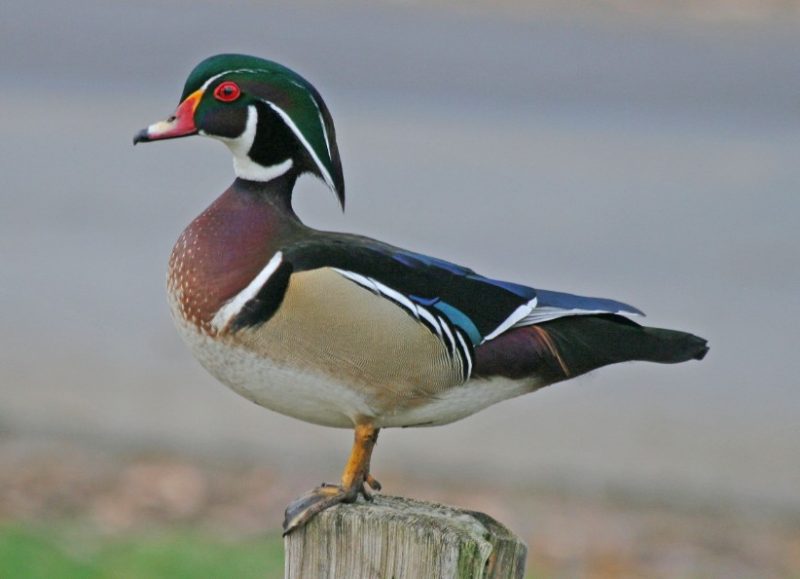
The Wood Duck is one of North America’s most colorful waterfowl, with males exhibiting iridescent green and purple plumage, red eyes, and a distinctive crested head. Females are more muted but still have a distinctive white eye-ring and spotted chest. Their high-pitched, squeaky calls are common near wooded wetlands.
In Alabama, Wood Ducks inhabit wooded swamps, ponds, and slow-moving streams with dense vegetation. They prefer nesting in tree cavities near water or use nest boxes provided by conservationists. These ducks are often seen swimming among water plants or perching in trees, showing their adaptability to forested aquatic habitats.
Their diet includes seeds, fruits, aquatic plants, and insects, which they forage both on water and on land. Wood Ducks are strong fliers with quick, direct flight and are highly sought after by birdwatchers for their striking appearance and unique habitat preferences.
Ruby-throated Hummingbird (Archilochus colubris)
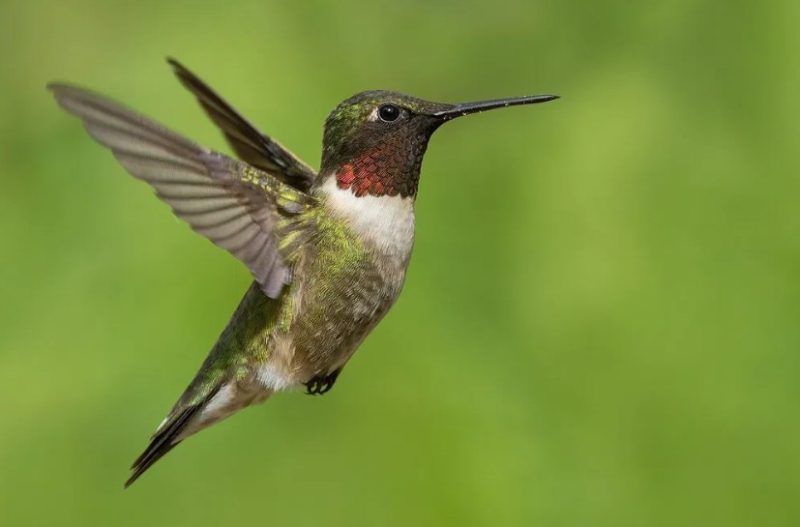
The Ruby-throated Hummingbird is a tiny, agile bird known for its iridescent emerald-green back and brilliant ruby-red throat patch on males. Females lack the red throat but have similar green plumage. Their rapid wingbeats create a humming sound, and they produce high-pitched chirps during flight.
In Alabama, Ruby-throated Hummingbirds are summer residents, arriving in spring to breed in woodlands, gardens, and open areas with abundant flowers. They nest in small cup-shaped nests made from plant down and spider silk, usually placed on slender tree branches.
Their diet consists mainly of nectar from flowers, supplemented by small insects and spiders caught on the wing. These birds play a crucial role as pollinators and are beloved for their energetic behavior and brilliant colors. Ruby-throated Hummingbirds are a highlight of Alabama’s spring and summer birdwatching.
Prothonotary Warbler (Protonotaria citrea)

The Prothonotary Warbler is a small songbird with bright golden-yellow plumage on its head and body and striking blue-gray wings and tail. Its vibrant colors make it one of the most eye-catching warblers in Alabama. It has a clear, ringing song that consists of repeated sweet notes, often heard near water.
In Alabama, this species inhabits wooded swamps, flooded bottomlands, and forested wetlands where it nests in tree cavities or nest boxes close to water. The Prothonotary Warbler prefers dense vegetation along slow-moving streams and is often found near cypress and tupelo swamps, making it somewhat specialized in its habitat requirements.
Their diet is mainly insects and spiders, which they glean from leaves and tree bark. They also occasionally eat small snails and seeds. Prothonotary Warblers are active and agile foragers, moving quickly through shrubs and branches. Their presence indicates healthy wetland ecosystems in Alabama.
Swallow-tailed Kite (Elanoides forficatus)
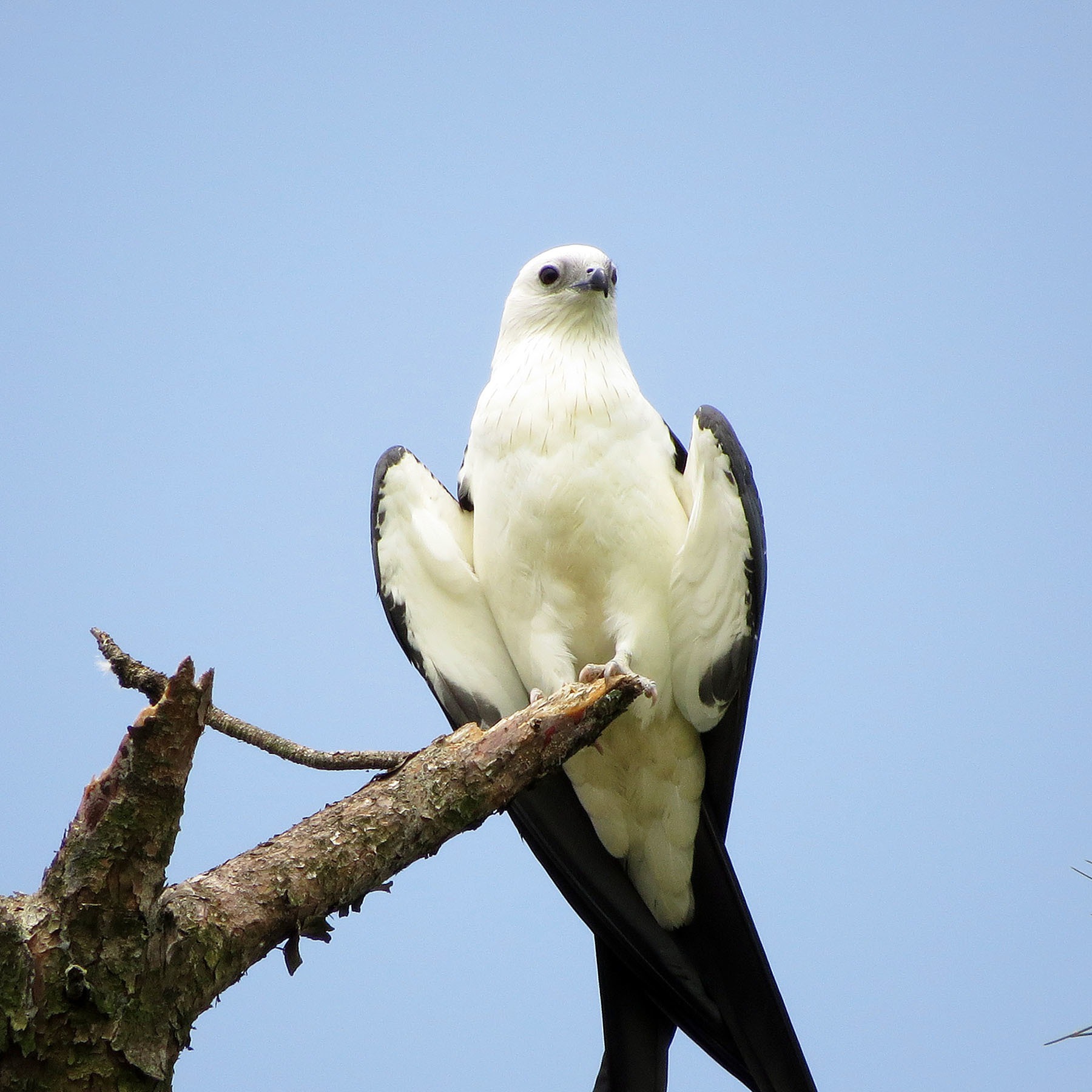
The Swallow-tailed Kite is a striking raptor with long, deeply forked tail feathers and graceful, slender wings. It is mostly white with black wings and tail, creating a dramatic contrast in flight. Known for its elegant soaring, this bird makes high-pitched, whistle-like calls that are often heard during the breeding season.
Swallow-tailed Kites breed in Alabama’s mature pine and hardwood forests near wetlands and rivers. They prefer open woodlands and forest edges where they can hunt flying insects and small vertebrates. Their nests are built high in tall trees, often overlooking water or open fields.
Their diet primarily consists of flying insects such as dragonflies and cicadas, but they also catch small birds, amphibians, and reptiles. Swallow-tailed Kites are remarkable for their aerial acrobatics, often seen gliding effortlessly or snatching prey mid-air. Their elegant flight and unique tail shape make them a favorite among birdwatchers.
Painted Bunting (Passerina ciris)
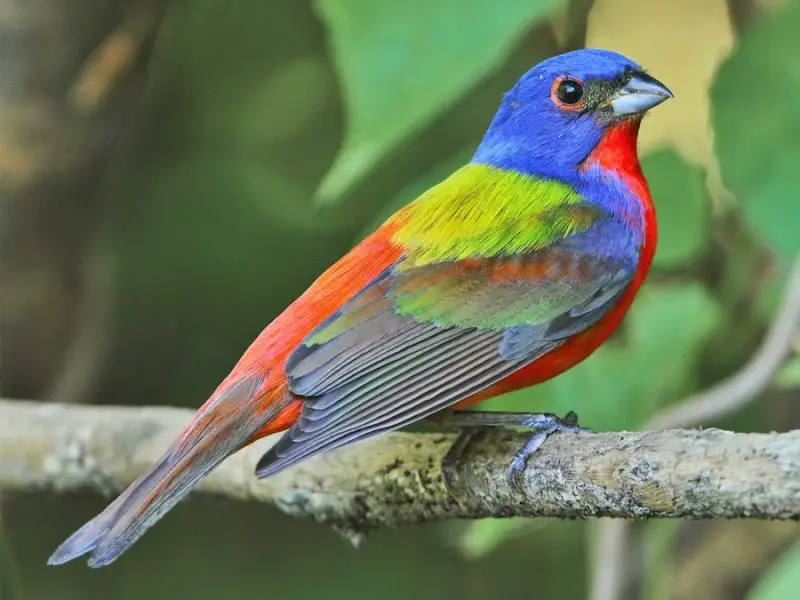
The Painted Bunting is a small, vibrantly colored songbird, with males displaying a rainbow of blue, green, red, and yellow feathers. Females and juveniles are more subdued in green and yellow tones. The male’s bright plumage and distinctive high-pitched, musical song make it a sought-after species in Alabama.
This bird favors shrubby habitats, woodland edges, and thickets across Alabama, especially during the breeding season. Painted Buntings nest low in dense bushes or small trees, creating cup-shaped nests where females incubate the eggs. They are secretive birds that can be challenging to spot despite their bright colors.
Their diet mainly consists of seeds, berries, and insects, which they forage both on the ground and in low vegetation. Painted Buntings are known for their shy behavior and tendency to remain hidden in thick cover, making glimpses of their vivid plumage a special experience for bird lovers.
Scissor-tailed Flycatcher (Tyrannus forficatus)

The Scissor-tailed Flycatcher is a medium-sized bird notable for its long, forked tail that can be twice the length of its body. It has a pale gray body, pinkish flanks, and a white belly. In flight, its tail spreads wide, giving it a dramatic, elegant appearance. Its call is a sharp, raspy “kip-kip” sound.
In Alabama, this species is usually seen in open areas such as farmland, roadsides, and pastures during the breeding season. They perch prominently on fences and utility wires, scanning for flying insects. Their aerial acrobatics while catching prey are impressive and a highlight of spring and summer birding.
The diet of Scissor-tailed Flycatchers mainly consists of flying insects like grasshoppers, beetles, and flies. They are skilled hunters, sallying out from perches to catch insects mid-air. Their graceful flight and striking tail make them unmistakable in Alabama’s open landscapes.
Belted Kingfisher (Megaceryle alcyon)
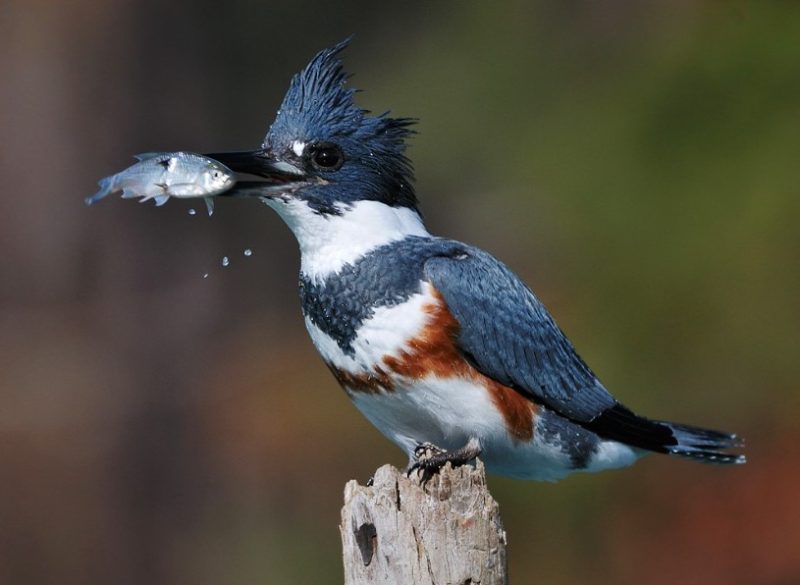
The Belted Kingfisher is a medium-sized bird with a large head, shaggy crest, and long, sharp bill. It has blue-gray upperparts, white underparts, and a broad blue band across the chest. Females have an additional rusty band on the belly. Its rattling call is loud and distinctive, often heard near water.
In Alabama, Belted Kingfishers are found near rivers, lakes, ponds, and coastal shores where they nest in burrows dug into sandy banks. They require clear water bodies with abundant fish and perches from which to hunt. These birds are often seen perched on branches or wires close to water.
Their diet primarily consists of small fish, which they catch by diving from perches. They also eat crustaceans and aquatic insects. Belted Kingfishers are territorial and can often be observed hovering briefly before plunging into water. Their fishing skills and striking appearance make them a well-known species across Alabama’s waterways.

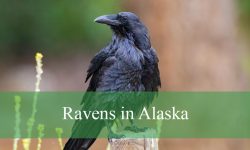
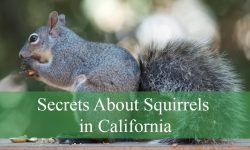
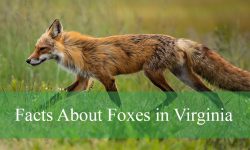
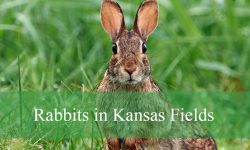
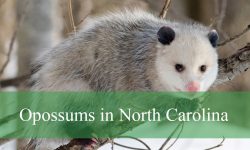

I was very impressed with the information ya’ll provided here.